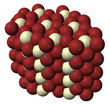Lanthanum(III) chloride
| |||
| Names | |||
|---|---|---|---|
| Other names
Lanthanum trichloride
| |||
| Identifiers | |||
3D model (JSmol)
|
|||
| ChemSpider | |||
| ECHA InfoCard | 100.030.202 | ||
PubChem CID
|
|||
CompTox Dashboard (EPA)
|
|||
| |||
| |||
| Properties | |||
| LaCl3 | |||
| Molar mass | 245.26 g/mol (anhydrous) 371.37 g/mol (heptahydrate) | ||
| Appearance | white odorless powder hygroscopic | ||
| Density | 3.84 g/cm3 | ||
| Melting point | 858 °C (anhydrous)[1] | ||
| Boiling point | 1000 °C (anhydrous) | ||
| very soluble | |||
| Solubility | soluble in ethanol (heptahydrate) | ||
| Structure | |||
| hexagonal (UCl3 type), hP8 | |||
| P63/m, No. 176 | |||
| Tricapped trigonal prismatic,(nine-coordinate) | |||
Except where otherwise noted, data are given for materials in their standard state (at 25 °C [77 °F], 100 kPa).
| |||
Lanthanum chloride is the inorganic compound with the formula LaCl3. It is a common salt but is mainly used in research. It is a white solid that is highly soluble in water and alcohols.
Structure
The La3+ centre is 9-coordinate in the trichloride. The structure is similar to that for uranium trichloride.
Preparation and reactions
It forms upon union of the elements, but a more commonly used method involves heating a mixture of lanthanum(III) oxide and ammonium chloride at 200-250 °C:[2]
- La2O3 + 6 NH4Cl → 2 LaCl3 + 6 NH3 + 2 H2O
From the trichloride, one can produce the other trihalides by exchange. Reduction with potassium gives metallic lanthanum.
Uses
Lanthanum chloride does not enjoy many applications. A possible application involves the precipitation phosphate from solutions, e.g. in swimming pools to prevent algae growth. It is also used in biochemical research to block the activity of divalent cation channels, mainly calcium channels. Doped with cerium, it is used as a scintillator material.
In organic synthesis, lanthanum trichloride functions as a mild Lewis acid for converting aldehydes to acetals.
The compound has been identified as a catalyst for the high pressure oxidative chlorination of methane to chloromethane with hydrochloric acid and oxygen.[3]
This compound is also used in Gamma Detectors, is one of the smallest sized (massed) meters of the inorganic compounds used for Gamma Ray Detectors.
References
- ^ Lide, David R., ed. (2006). CRC Handbook of Chemistry and Physics (87th ed.). Boca Raton, FL: CRC Press. ISBN 0-8493-0487-3.
- ^ Handbook of Preparative Inorganic Chemistry, 2nd Ed. Edited by G. Brauer, Academic Press, 1963, NY.
- ^ Podkolzin SG, Stangland EE, Jones ME, Peringer E, Lercher JA (2007). "Methyl chloride production from methane over lanthanum-based catalysts". J. Am. Chem. Soc. 129 (9): 2569–76. doi:10.1021/ja066913w. PMID 17295483.
{{cite journal}}: CS1 maint: multiple names: authors list (link)


